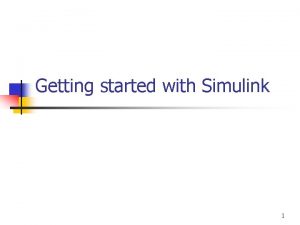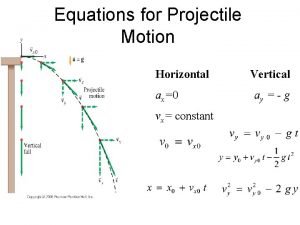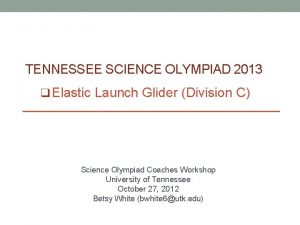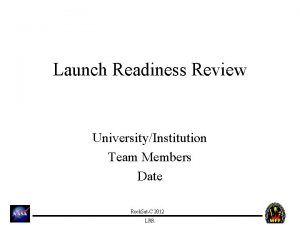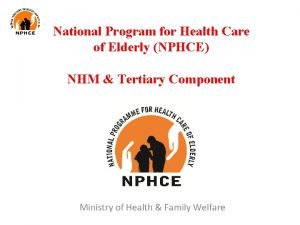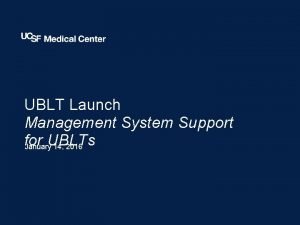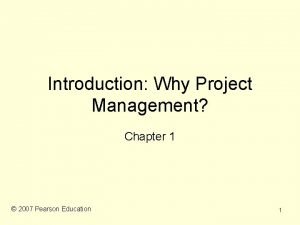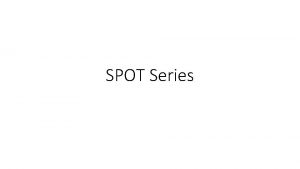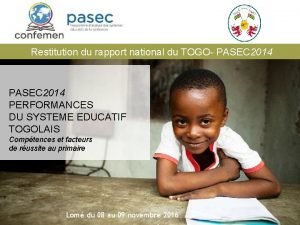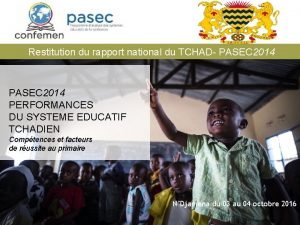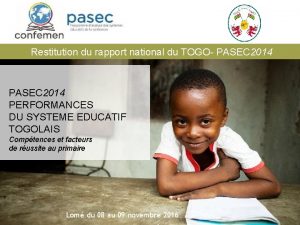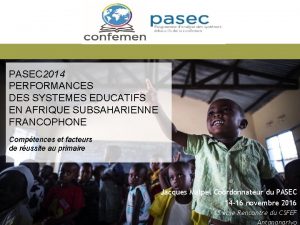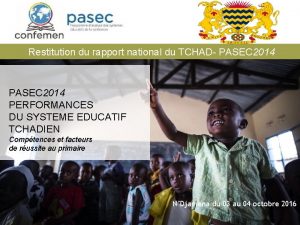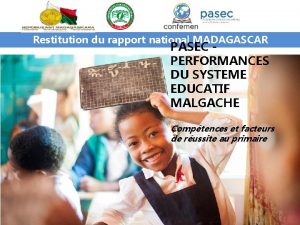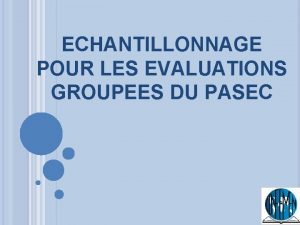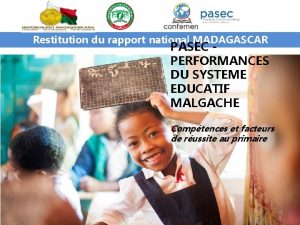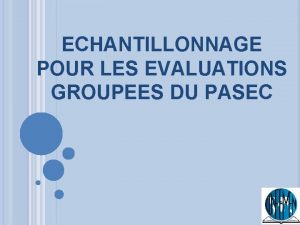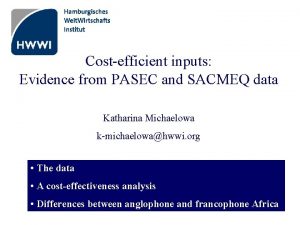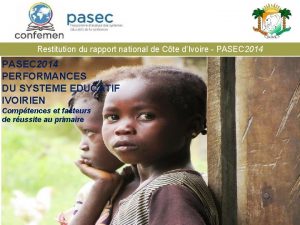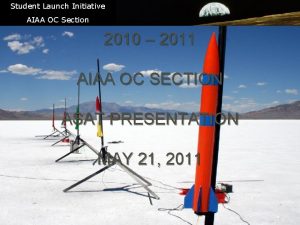Launch of the PASEC 2014 Report PASEC 2014















































- Slides: 47

Launch of the PASEC 2014 Report PASEC 2014 EDUCATION SYSTEM PERFORMANCE IN FRANCOPHONE SUB-SAHARAN AFRICA Competencies and Learning Factors in Primary Education 7 December 2015 Almadies Hotel, Dakar

Contents 1 The PASEC 2014 Survey Context, Goals and Methodology 2 Primary Pupil Competency Levels 3 Factors of Learning Achievements 4 Avenues for Reflection Launch of the PASEC 2014 Report, 7 December 2015, Dakar 2

1 The PASEC 2014 Survey Context, Goals and Methodology

PASEC supports the steering of CONFEMEN member countries’ education systems with the aim of improving the quality of education. The Conference of Ministers of Education of French-Speaking Countries (CONFEMEN) has been working, since its creation in 1960, for the promotion of education and vocational and technical training. 44 state and government members. 3 basic missions: Created in 1991, the CONFEMEN Programme for the Analysis of Education Systems (PASEC) aims to document the evolution of education system performance in order to support the elaboration and monitoring of education policies. 35 national assessments in over twenty countries in Africa, Asia and the Middle East. • Inform its members on the evolution of education systems and ongoing reforms; • Contribute to reflections on topics of common interest with a view to taking concerted action; and PASEC is built on 3 pillars: • Reliable data, and solid and relevant analysis. Facilitate consultations between ministers and experts to reach common positions and formulate recommendations in support of regional and international education policies. • Strengthened capacities. • Results exploited in education sector steering and reform. • Launch of the PASEC 2014 Report, 7 December 2015, Dakar national assessment 4

Large-Scale Assessments (LSAs) of pupil competencies are tools to monitor and evaluate education policy. Main Characteristics of LSAs • Approach Appraisal • • • Tests measure the competencies of samples of pupils that are representative of the school-aged population for different grades. Questionnaires collect information on characteristics of pupils and their school and family environments. Quality of learning achievements Knowledge and abilities required to pursue education Learning outcomes School environment Equity of education systems, regardless of origin or learning context Launch of the PASEC 2014 Report, 7 December 2015, Dakar 5

PASEC 2014 is the first edition of the new PASEC assessment model in Francophone Sub-Saharan Africa. PASEC 2014 Focus on the international comparability of pupil competencies at the beginning and the end of the primary cycle to analyze and better understand the effectiveness and equity of education systems. • Measure competencies at the beginning and the end of the primary cycle (Grade 2 and Grade 6) in two key subjects (language and mathematics) o Be able to provide necessary remediation to the quality of teaching and learning, from the earliest opportunity. o Measure the competencies whose mastery will determine future schooling, careers and social integration. • Analysis of the factors of learning achievements Country-by-country analysis + Comparative analysis Launch of the PASEC 2014 Report, 7 December 2015, Dakar 6

Ten countries of Francophone Sub-Saharan Africa participated in this first edition of the wide-scale comparative assessment of education systems. Benin Burkina Faso Burundi Cameroon Chad Congo Côte d’Ivoire Niger Senegal Togo 1, 800 schools 40, 000 pupils Launch of the PASEC 2014 Report, 7 December 2015, Dakar 7

PASEC 2014 compares pupils’ competencies to better understand the effectiveness and equity of education systems. Tests to measure competency levels Language Tests Early and Late Primary Mathematics Tests Early and Late Primary Questionnaires to comprehend the factors Characteristi cs of pupils and their family environment The country, its education system and regions Pupils prior schooling and experiences School and class environme nt Pupil behavior, attitudes and strategies Launch of the PASEC 2014 Report, 7 December 2015, Dakar 8

The PASEC 2014 tests were designed according to a scientific process that adheres to international assessment standards. Language Tests Part 1 : Listening Comprehension Early Primary Part 2 : Familiarization with Written Language and Reading -Decoding Mathematics Tests Part 1 : Arithmetic Part 2 : Geometry, Space and Measurement Part 3 : Reading Comprehension Late Primary Decoding Isolated Words and Sentences 26% Reading Comprehension 74% Arithmetic 46, 9% Measurement 35, 8% Geometry and Space 17, 3% Launch of the PASEC 2014 Report, 7 December 2015, Dakar 9

PASEC has developed specific competency scales for each grade and subject, defining a “sufficient” competency threshold. Language Competency Levels Mathematics Competency Levels Level 4 Level 3 Level 2 “Sufficient” Competency Threshold Level 1 Below Level 1 The “sufficient” threshold enables to determine the share of pupils that face a greater probability of mastering – or not – the knowledge and abilities deemed necessary to pursue their schooling in good conditions. Launch of the PASEC 2014 Report, 7 December 2015, Dakar 10

Language – Early Primary Description of Competency Levels Distribution of Pupils throughout the Levels of the Scale Level 4 14. 1% Intermediate reader: enhanced reading autonomy is bolstering their understanding of sentences and texts 14. 5% Novice reader: gradual improvement of written language decoding, listening comprehension and reading comprehension skills Level 3 Description of Competencies “Sufficient” Competency Threshold Level 2 28. 7% Emerging reader: gradual development of written language decoding skills and reinforcement of listening comprehension skills Level 1 30. 3% Early reader: first contact with the oral and written language Below Level 1 12. 4% In difficulty with Level 1 knowledge and competencies. Launch of the PASEC 2014 Report, 7 December 2015, Dakar 11

Language – Early Primary Examples of Test Items Level 1 Ø Level 3 Competency: Recognize Spoken Vocabulary Question : “Show me your hand? ” Ø Competency: Decode and Recognize the Meaning of Isolated Words Question: “Show me the picture that goes with the word: ” Launch of the PASEC 2014 Report, 7 December 2015, Dakar 12

Mathematics – Early Primary Description of Competency Levels Distribution of Pupils throughout the Levels of the Scale Level 3 23. 2 % Level 2 29. 7 % Level 1 30. 9 % Below Level 1 16. 2 % Description of Competencies Master the oral number sequence. Compare numbers, complete logical series and perform operations with numbers over 50. Solve basic problems with numbers under twenty using reasoning skills. Recognize and compare numbers up to 100. Complete logical series and perform operations with numbers under 50. Manage concepts of orientation in space. Develop an ability to solve basic problems with numbers under 20 using reasoning skills. “Sufficient” Competency Threshold Progressively develop their knowledge of the mathematical language. Master the first concepts of quantity with objects and numbers under 20. Appraise the relative size of objects, recognize simple geometric shapes and develop awareness of the first concepts of orientation in space. Launch of the PASEC 2014 Report, 7 December 2015, Dakar In difficulty with Level 1 knowledge and competencies. 13

Mathematics – Early Primary Examples of Test Items Level 1 Level 3 Competency: Order Numbers Under 20 Ø Competency: Add Two Numbers whose Total is Over 50 Question: “Show me the smallest number” Launch of the PASEC 2014 Report, 7 December 2015, Dakar 14

Language – Late Primary Description of Competency Levels Level 4 Level 3 Distribution of Pupils throughout the Levels of the Scale 17. 1 % 25. 6 % Description of Competencies Processing of narrative passages, informative texts and documents: • Associate and interpret implicit ideas • Identify the author’s intention, determine implicit meaning and interpret characters’ feelings • Connect information and compare data prior to use. Combine two pieces of explicit information from a document or carry out simple inferences in a narrative or informative text. Extract implicit information from written material while giving meaning to implicit connectors, anaphora or referents. Locate explicit information in long texts and discontinuous documents. “Sufficient” Competency Threshold Level 2 27. 7 % Level 1 21. 2 % Below Level 1 8. 4 % Identify and understand isolated words. Locate explicit information in short and medium length texts. Paraphrase explicit information from a text. Developed decoding skills and draw on them to understand isolated words taken from their everyday lives. In difficulty understanding the meaning of short and simple texts. In difficulty with Level 1 knowledge and competencies. Launch of the PASEC 2014 Report, 7 December 2015, Dakar 15

Language – Late Primary Examples of Test Items (1/2) Level 1 Competency: Decode and recognize information Question: “Tick the box in which you can see a foot. ”” Launch of the PASEC 2014 Report, 7 December 2015, Dakar 16

Language – Late Primary Examples of Test Items (2/2) Level 4 Ø Competency: Read a document to interpret and combine information Launch of the PASEC 2014 Report, 7 December 2015, Dakar 17

Mathematics – Late Primary Description of Competency Levels Distribution of Pupils throughout the Levels of the Scale Level 3 14. 7 % Level 2 26. 3 % Description of Competencies Answer arithmetic and measurement questions requiring analysis of situations Solve problems involving fractions or decimal numbers Solve problems involving surface area or perimeter calculations Find data on a diagram prior to calculating distances Perform calculations and conversions involving hours, minutes and even seconds. Answer brief arithmetic, measurement and geometry questions resorting to the three assessed processes: knowing, applying and reasoning. Perform operations with decimal numbers and solve familiar problems. Complete logical series with decimal numbers or fractions. Convert units of measurement with or without a conversion table. Solve arithmetic problems involving operations with days, hours and minutes, or units of length. Know the names of certain solids, basic geometric shapes and some characteristic lines. “Sufficient” Competency Threshold Level 1 31. 8 % Answer very brief questions by calling upon factual knowledge or a specific procedure. Carry out the four basic operations with whole numbers, potentially with regrouping. Recognize the length measurement unit: the meter. , and orientate themselves in space by identifying directions and positions and by reading coordinates on a graph. Below Level 1 27. 2 % In difficulty with Level 1 knowledge and competencies. Launch of the PASEC 2014 Report, 7 December 2015, Dakar 18

Mathematics – Late Primary Examples of Test Items Level 1 Ø Level 3 Competency: Know everyday measurement units Question: “What units do you use to measure the length of a classroom? ” Competency: Reason through a pre algebraic calculation Question: “When you multiply a number by 3 and add 100, you get 790. What is the number you started with? ” Launch of the PASEC 2014 Report, 7 December 2015, Dakar 19

2 Primary Pupil Competency Levels Launch of the PASEC 2014 Report, 7 December 2015, Dakar 20

A vast majority of pupils do not display the competencies expected in primary school. 70% 60% of early primary pupils are below the “sufficient” threshold in language of late primary pupils are below the “sufficient” threshold, in reading and mathematics 50% of early primary pupils are below the “sufficient” threshold in mathematics Launch of the PASEC 2014 Report, 7 December 2015, Dakar 21

In virtually all the education systems assessed, a majority of pupils demonstrate major shortcomings. For some countries, the situation is alarming. Early Primary Late. Primary “Sufficient ” Competency Threshold Average Launch of the PASEC 2014 Report, 7 December 2015, Dakar 22

Countries can be classed into four groups according to the percentage of pupils reaching the thresholds in language and/or mathematics. Late Primary Early Primary 1 80% in language and 70% in mathematics 1 country 2 33% in language and 60% in mathematics 2 countries 3 20%-30% in language and 50% in mathematics 3 countries 4 <20% in language and 30%40% in mathematics 4 countries 1 >50% in language and in mathematics 3 countries 2 >50% in language and 20%50% in mathematics 3 countries 3 20%-50% in language and in mathematics 2 countries 4 <20% in language and in mathematics 2 countries Launch of the PASEC 2014 Report, 7 December 2015, Dakar 23

Average national scores illustrate the position of each country, in each subject, comparative to the PASEC 2014 average set at 500 points. Early Primary Launch of the PASEC 2014 Report, 7 December 2015, Dakar 24

Average national scores illustrate the position of each country, in each subject, comparative to the PASEC 2014 average set at 500 points. Late Primary Launch of the PASEC 2014 Report, 7 December 2015, Dakar 25

The results reveal the existence of a strong positive relationship between pupil performance levels in language and mathematics. School Pupil Correlation Coefficient between Language and Mathematics Scores – Early Primary Between 0. 66 and 0. 85 Between 0. 88 and 0. 98 Whatever the country • Pupils and schools that are successful in language achieve high mathematics scores • Pupils and schools that are not successful in language achieve low mathematics scores The learning of mathematics throughout schooling is highly dependent on the level of mastery of the language of instruction, from the very first grades or primary. Launch of the PASEC 2014 Report, 7 December 2015, Dakar 26

In almost all countries, there are considerable competency gaps between pupils, apparent as of the first grades of primary. Performance Gaps between the Best and Weakest Pupils Early Primary Late Primary Launch of the PASEC 2014 Report, 7 December 2015, Dakar 27

Generally speaking, countries above the average* at the beginning of primary also out-perform the average at the end of primary. Comparison of Average Scores in Reading and Mathematics – Early and Late Primary Language Mathematics (*) PASEC 2014 Average Launch of the PASEC 2014 Report, 7 December 2015, Dakar 28

3 Factors of Learning Achievements Launch of the PASEC 2014 Report, 7 December 2015, Dakar 29

Disparities between families and in initial schooling careers translate into learning gaps at the beginning and the end of the primary cycle. Pupil Learning Achievement Factors q Pupils who attended preprimary obtain better results, especially in language. q Late entry to school is negatively correlated with pupil performance. q Pupils who have never repeated achieve better learning outcomes. q Performance gaps are unfavorable to pupils participating in agricultural or petty commerce activities, especially in reading. q In 9 countries in 10, pupils at least one of whose parents can read achieve better scores than their peers. q In 6 countries in 10, mathematics scores are significantly lower among pupils having no books at home. Attended Preprimary Family Socioeconomic Status is High Started School at Official Age Has Literate Parents Never Repeated Participated (or not) in Agricultural or Petty Commerce Activities Launch of the PASEC 2014 Report, 7 December 2015, Dakar 30

Pupil learning achievements are also related to school characteristics and the availability of resources. • In 8 countries in 10, pupils in private schools achieve better results than their peers. • The performance of pupils attending schools in urban areas outstrips that of their peers in rural areas. • Schools offering the best learning environments (infrastructure, pedagogical resources, health and hygiene) tend to produce better results. • The performance of pupils in standard classes is better than that of their peers in multi-grade or double-shift classes. Launch of the PASEC 2014 Report, 7 December 2015, Dakar 31

In early primary, pupils benefit from fewer resources than in late primary. Early Primary Late Primary Generally speaking, over 80% of pupils have teachers whose academic level reaches secondary at best. In 8 countries in 10, between 10% and 25% of pupils have a teacher who received no pre-service teacher training. In 8 countries in 10, at least 40% of pupils have a teacher with over 10 years of seniority. In 3 countries in 10, 50% to 60% of pupils have teachers with university-level education. Except for 2 countries, close to 90% of pupils have a teacher who followed pre-service teacher training. 50% to 70% of pupils have a teacher with over 10 years of seniority. Launch of the PASEC 2014 Report, 7 December 2015, Dakar 32

4 Avenues for Reflection Launch of the PASEC 2014 Report, 7 December 2015, Dakar 33

PASEC 2014: Avenues for Reflection 1 Promote preprimary education. Access for all to preprimary education can be a factor of improvement of the effectiveness and equity of education systems. Access to preprimary school can, among others, enable children to familiarize themselves with the learning process and the teaching language before their arrival in primary school. Launch of the PASEC 2014 Report, 7 December 2015, Dakar 34

PASEC 2014: Avenues for Reflection 2 Reflect on the articulation between the teaching language and mother tongue in the early grades of primary. The level of competencies achieved in early primary plays a decisive role in children’s later schooling. It is worth reflecting on the articulation between pupils’ mother tongue, the language of instruction and reading and mathematics learning during the first years of primary, that constitute a critical period for future schooling. Launch of the PASEC 2014 Report, 7 December 2015, Dakar 35

PASEC 2014: Avenues for Reflection 3 Strengthen the support provided to early primary pupils, especially in reading. Provide pedagogical support to pupils that cumulate difficulties in both reading and mathematics from the beginning of their primary education. Analyze the nature of learning difficulties and implement appropriate teaching practices. Launch of the PASEC 2014 Report, 7 December 2015, Dakar 36

PASEC 2014: Avenues for Reflection 4 Rethink assessment and promotion policies and implement support measures for pupils in great difficulty. Assess the effectiveness of the practice of repetition. Review the quality and appropriateness of intracycle assessment and promotion practices. Launch of the PASEC 2014 Report, 7 December 2015, Dakar 37

PASEC 2014: Avenues for Reflection 5 Improve the quality, availability and allocation of school equipment and pedagogical resources. Ensure the availability of school equipment and resources, as well as their equitable distribution among schools nationwide. Launch of the PASEC 2014 Report, 7 December 2015, Dakar 38

PASEC 2014: Avenues for Reflection 6 Strengthen teacher training and upgrade teacher status. Appraise the performance of teacher training systems and to propose avenues for their improvement. Conduct a thorough reflection on teachers’ working conditions, in order to remotivate them. Launch of the PASEC 2014 Report, 7 December 2015, Dakar 39

PASEC 2014: Avenues for Reflection 7 Stimulate girls’ interest in mathematics. Encourage girls in scientific subjects. Include modules in teacher training courses on the gender stereotypes projected by schools. Launch of the PASEC 2014 Report, 7 December 2015, Dakar 40

PASEC 2014: Avenues for Reflection 8 Implement family sensitization and support mechanisms. Implement mechanisms to support families that are not literate. Sensitize families on the negative impact of agricultural work and petty commerce on pupil performance. Launch of the PASEC 2014 Report, 7 December 2015, Dakar 41

PASEC 2014: Avenues for Reflection 9 Consider the situation of pupils not achieving satisfactory results by the end of primary. Adopt emergency measures in order to support pupils leaving primary without the required competencies to pursue their education. Launch of the PASEC 2014 Report, 7 December 2015, Dakar 42

PASEC 2014: Avenues for Reflection 1 2 3 Promote Preprimary Education Reflect on the articulation between the teaching language and mother tongue in the early grades of primary Strengthen the support provided to early primary pupils, especially in reading 4 5 6 Rethink assessment and promotion policies and implement support measures for pupils in great difficulty Improve the quality, availability and allocation of school equipment and pedagogical resources Strengthen teacher training and upgrade teacher status 7 8 9 Stimulate girls’ interest in mathematics Implement family sensitization and support mechanisms Consider the situation of pupils not achieving satisfactory results by the end of primary Launch of the PASEC 2014 Report, 7 December 2015, Dakar 43

The PASEC 2014 findings raise questions about national education policy. Place pupil learning achievements at the heart of national policy? • Provide each pupil with the necessary competencies to pursue their schooling in good conditions and for their economic and social integration. • Include the acquisition of competencies among the key goals of national education policy. • Adopt and use monitoring and evaluation tools such as the PASEC 2014 scale and competency benchmarks. Launch of the PASEC 2014 Report, 7 December 2015, Dakar 44

The PASEC web-page provides access to data and publications and facilitates communication with stakeholders. www. pasec. confemen. org Launch of the PASEC 2014 Report, 7 December 2015, Dakar 45

NEXT STEPS Make the international database available to researchers and the education community Prepare the next assessment cycle Publish national reports in 2016 Pursue the PASEC 2014 work in greater detail Launch of the PASEC 2014 Report, 7 December 2015, Dakar 46

Complexe Sicap Point E, Immeuble C 3ème étage, avenue Cheikh Anta Diop BP 3220, Dakar Sénégal Tél. (221) 33 859 29 79 / 33 859 29 91 pasec@confemen. org confemen@confemen. org www. pasec. confemen. org www. confemen. org
 Pasec cameroun
Pasec cameroun Simulink
Simulink Height formula physics
Height formula physics The openblend podcast
The openblend podcast That was due today
That was due today Elastic launch glider
Elastic launch glider Fake torrent
Fake torrent Launch readiness review
Launch readiness review Product launch presentation
Product launch presentation Nohce
Nohce Fighter brand examples
Fighter brand examples James nasa says space launch its
James nasa says space launch its Student launch initiative
Student launch initiative Optimal driver launch angle and spin rate chart
Optimal driver launch angle and spin rate chart First nations launch
First nations launch Launch housing dandenong
Launch housing dandenong How to launch an sto
How to launch an sto Ublt
Ublt Launch out into the deep
Launch out into the deep Kendra legge
Kendra legge Launch readiness review
Launch readiness review Stm brighton launch
Stm brighton launch Wbs for product launch
Wbs for product launch Narrow product launch windows
Narrow product launch windows Launch out into the deep hymn
Launch out into the deep hymn Jwst timeline
Jwst timeline Post launch review
Post launch review Yammer post examples
Yammer post examples Sample introduction for project
Sample introduction for project Narrow product launch windows
Narrow product launch windows Some month with no attached launch
Some month with no attached launch Flowarm pltw software
Flowarm pltw software Jeff walker plf
Jeff walker plf Launch yourself
Launch yourself Trời xanh đây là của chúng ta thể thơ
Trời xanh đây là của chúng ta thể thơ Thế nào là hệ số cao nhất
Thế nào là hệ số cao nhất Hệ hô hấp
Hệ hô hấp Lp html
Lp html Các số nguyên tố
Các số nguyên tố đặc điểm cơ thể của người tối cổ
đặc điểm cơ thể của người tối cổ Các châu lục và đại dương trên thế giới
Các châu lục và đại dương trên thế giới Tư thế worm breton
Tư thế worm breton ưu thế lai là gì
ưu thế lai là gì Tư thế ngồi viết
Tư thế ngồi viết Cái miệng nó xinh thế chỉ nói điều hay thôi
Cái miệng nó xinh thế chỉ nói điều hay thôi Mật thư tọa độ 5x5
Mật thư tọa độ 5x5 Các châu lục và đại dương trên thế giới
Các châu lục và đại dương trên thế giới Từ ngữ thể hiện lòng nhân hậu
Từ ngữ thể hiện lòng nhân hậu

